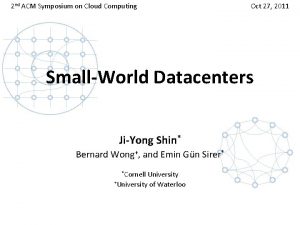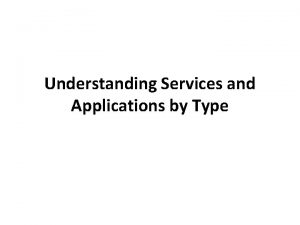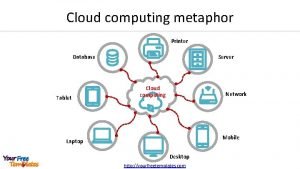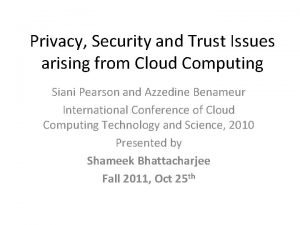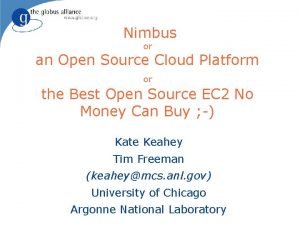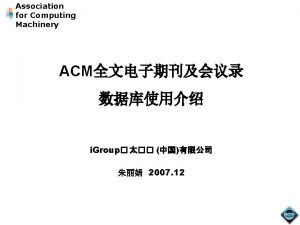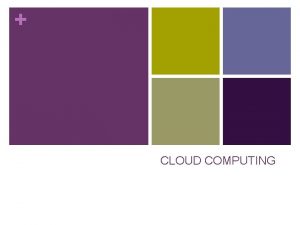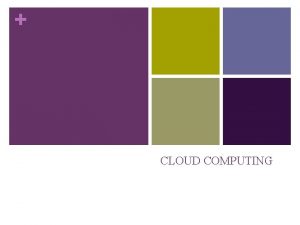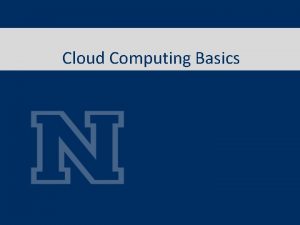2 nd ACM Symposium on Cloud Computing Oct



















- Slides: 19

2 nd ACM Symposium on Cloud Computing Oct 27, 2011 Small-World Datacenters Ji-Yong Shin* Bernard Wong+, and Emin Gün Sirer* *Cornell University +University of Waterloo

Motivation • Conventional networks are hierarchical – Higher layers become bottlenecks • Non-traditional datacenter networks are emerging – Fat Tree, VL 2, DCell and BCube • Highly structured or sophisticated regular connections • Redesign of network protocols – Cam. Cube (3 D Torus) • High bandwidth and APIs exposing network architecture • Large network hops

Small-World Datacenters • Regular + random connections – Based on a simple underlying grid – Achieves low network diameter – Enables content routing • Characteristics – High bandwidth – Fault tolerant – Scalable

Small-World Networks • Watts and Strogatz – Multiple connections to neighbors on a ring + random connections • Kleinberg – Lattice + random links – Probability of connecting a random pair decreases with dth power of distance between the pair in d-dimensional network – Path length becomes O(log n) Watts and Strogatz’ 98 Kleinberg’ 00

Small-World Datacenter Design • Possible topologies for 6 links per node Small World Ring (2 reg + 4 rand) Small World 2 D Torus (4 reg + 2 rand) Small World 3 D Hexagon Torus (5 reg + 1 rand) • Direct connections from server to server – No need for switches – Software routing approach

Routing in Small-World Datacenters • Shortest path – Link state protocol (OSPF) – Expensive due to TCAM cost • Greedy geographical – Find min distance neighbor – Coordinates in lattice used as ID – Maintain info of 3 hop neighbors – Comparable to shortest path for 3 DHex. Torus

Content Routing in Small-Worlds • Content routing – Logical coordinate space and network to map data – Logical and physical network do not necessarily match • Geographical identity + simple regular network in SWDC – Logical topology can be mapped physically – Random links only accelerates routing • SWDC can support DHT and key value stores directly – Similar to Cam. Cube

Packaging and Scaling • SWDCs can be constructed from preconfigured, reusable, scalable components • Reusable racks – Regular links: only short cables necessary – Random links: • Predefined Blueprint • Random number generator * • Pre-cut wires based on known probability • Ease of construction – Connect rack-> cluster (or container) -> datacenter – Switches, repeaters, or direct wires for inter-cluster connections *Image from http: //www. chuck-a-con. net/Dice. html

Evaluation Setup • Simulation of 10, 240 nodes in three settings: – Small-World Datacenters (SWDC) – Cam. Cube SW Ring SW 2 DTorus SW 3 DHexagonal Torus Cam. Cube • 6 x 1 Gig. E links per server • Greedy routing • Net. FPGA Setup − 64 B packet 4. 6 us − 1 KB packet 15 us – Conventional hierarchical data centers (CDC) • • 1 x 1 Gig. E link per server 10 Gig. E links among switches 3 layer switches (Uniform delays: 6 us, 3. 2 us, and 5 us in each layer) Oversubscriptions: 5 and 10

Evaluation: Average Packet Latency 600 Latency (us) 500 400 300 Average Packet Latency: Uniform Random • SWDCs always outperform Cam. Cube SW Ring SW 2 DTorus SW 3 DHex. Torus 200 100 0 64 B 1 KB Latency (us) Packet Size 450 400 350 300 250 200 150 100 50 0 Average Packet Latency: Map. Reduce • SWDCs can outperform CDC for Map. Reduce – SWDC has multiple ports • SWDC latencies are packet size dependent – Limitations of software routers 64 B 1 KB Packet Size

Evaluation: Aggregate Bandwidth (GBps) 350 300 250 200 150 Aggregate Bandwidth: Uniform Random SW Ring SW 2 DTorus SW 3 DHex. Torus • SWDCs outperform Cam. Cube in general – 1. 5 x - 3 x better 100 50 0 64 B 1 KB Packet Size Bandwidth (GBps) 160 Aggregate Bandwidth: Map. Reduce 140 120 100 80 60 40 20 0 64 B 1 KB Packet Size • SWDCs outperform CDCs in general – 1 x - 16 x better

Evaluation: Fault Tolerance Percentage of preserved connectivity Connectivity under random rack failure 100 90 80 70 60 50 40 30 20 10 0 SW Ring SW 2 DTorus SW 3 DHex. Torus Cam. Cube 0 10 20 30 40 50 60 Percentage of failed racks 70 • No switches to fail compared to CDCs • Random links enable stronger connections 80 90

Related Concurrent Work • Scafida and Jellyfish – Rely on random connections – Achieve high bandwidth • Comparison to SWDC – SWDCs have more regular links – Routing can be simpler

Summary • Unorthodox topology comprising a mix of regular and random links can yield: – High performance – Fault tolerant – Easy to construct and scalable • Issues of cost at scale, routing around failures, multipath routing, etc. are discussed in the paper

Extra: Path Length Comparison Average Path Length (10240 nodes, Errorbar = stddev) Path Length 30 25 20 Shortest Greedy 15 10 5 0 SW Ring SW 2 DTorus SW 3 DHex. Torus Cam. Cube

Extra: Load balance

Extra: Need for Hardware

Extra: Path Length Under Failure Shortest path length under random node failure Average Path Length 35 SW Ring 30 SW 2 DTorus SW 3 DHex. Torus 25 Cam. Cube 20 15 10 5 0 0 10 20 30 40 50 Percentage of failed nodes 60 70

Percentage of preserved path Extra: Fault Tolerance (node failure) Connectivity among live nodes under random correlated failure 100 90 80 70 60 50 40 30 20 10 0 SW Ring SW 2 DTorus SW 3 DHex. Torus Cam. Cube 0 10 20 30 40 50 60 Percentage of failed nodes • No switches to fail compared to CDCs • Random links enable stronger connections 70 80 90
 Acm symposium on cloud computing
Acm symposium on cloud computing Computing refers to applications and services that run on a
Computing refers to applications and services that run on a Conventional computing and intelligent computing
Conventional computing and intelligent computing Dpfs in cloud computing
Dpfs in cloud computing Pods aggregation and silos in cloud computing
Pods aggregation and silos in cloud computing Distributed file system in cloud computing
Distributed file system in cloud computing Dryad in cloud computing
Dryad in cloud computing Green computing seminar
Green computing seminar Isolation in cloud computing
Isolation in cloud computing Cloud computing metaphor
Cloud computing metaphor Cloud computing tunisie
Cloud computing tunisie Full virtualization in cloud computing
Full virtualization in cloud computing Cloud computing basic concepts
Cloud computing basic concepts Azzedine benameur
Azzedine benameur Nimbus in cloud computing
Nimbus in cloud computing Measuring cloud computing costs
Measuring cloud computing costs Intel to some cpu chips
Intel to some cpu chips Cloud computing database
Cloud computing database Hvad er cloud computing
Hvad er cloud computing Cloud computing in education
Cloud computing in education
